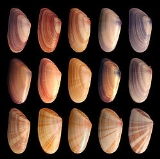
Donax
Encyclopedia
- For the MarantaceaeMarantaceaeThe Marantaceae or arrowroot family is a family of flowering plants known for its large starchy rhizomes. It is sometimes called the prayer-plant family...
genus, see Donax (plant).
Donax is a genus
Genus
In biology, a genus is a low-level taxonomic rank used in the biological classification of living and fossil organisms, which is an example of definition by genus and differentia...
of small, edible saltwater clams, marine
Marine (ocean)
Marine is an umbrella term. As an adjective it is usually applicable to things relating to the sea or ocean, such as marine biology, marine ecology and marine geology...
bivalve mollusks. The genus is sometimes known as bean clams; however, Donax species have various common names in different parts of the world.
Species of Donax live, sometimes in high concentrations, vertically aligned in the sand on exposed beaches, on tropical and temperate coasts worldwide. When the waves wash these small clams out of the sand, they can dig back in again quite rapidly. They are filter feeder
Filter feeder
Filter feeders are animals that feed by straining suspended matter and food particles from water, typically by passing the water over a specialized filtering structure. Some animals that use this method of feeding are clams, krill, sponges, baleen whales, and many fish and some sharks. Some birds,...
s. Some species, such as Donax variabilis
Donax variabilis
Donax variabilis is a species of mollusc found on the east coast of the United States from Virginia to the Caribbean. Its common name is coquina....
, migrate vertically and horizontally with changes in the tide
Tide
Tides are the rise and fall of sea levels caused by the combined effects of the gravitational forces exerted by the moon and the sun and the rotation of the Earth....
s.
Species
Species within the genus Donax include:- Donax carinatus
- Donax cuneatus
- Donax denticulatus
- Donax dentifer
- Donax faba
- Donax fossor - Used to be thought to be simply a northern form of D. variabilis, but it now seems to be the case that the Donax found in the most northerly part of the range, including the outer shores of Long Island, New York, is in fact not a paler northern version of D. variabilis, but a different species, D. fossor.
- Donax gouldiiDonax gouldiiDonax gouldii, the bean clam, is a marine bivalve mollusk species in the genus Donax. It is found on the Pacific coast of North America. This species, known for periodic population explosions, was eaten by Native Americans in southern California, particularly the Luiseno and Kumeyaay Indians of...
- The bean clam - Donax hanleyanusDonax hanleyanusDonax hanleyanus, common name the wedge clam , is a marine bivalve mollusk species in the family Donacidae, the bean clams or wedge shells. It is found widely distributed through sandy beaches of the Atlantic coast of South America, from Brazil to Argentina....
- Donax madagascariensis
- Donax oweni
- Donax pallidus
- Donax peruvianus
- Donax punctatostriatus
- Donax trunculus - Locally known as tellin, tellinaTellinaTellina is a widely distributed genus of marine bivalve molluscs, in the family Tellinidae.- Species :* Tellina aequistriata Say, 1824: striate tellin* Tellina agilis Stimpson, 1857: northern dwarf tellin, northern dwarf-tellin...
or telline in French and coquina in Spanish. - Donax variabilisDonax variabilisDonax variabilis is a species of mollusc found on the east coast of the United States from Virginia to the Caribbean. Its common name is coquina....
- Known in Florida under the Spanish word "coquina", is the common and colorful Donax species of the southern Atlantic and Gulf shores from Virginia to the Caribbean. This species is locally abundant on beaches with fine sand from the mid-Atlantic coast to TexasTexasTexas is the second largest U.S. state by both area and population, and the largest state by area in the contiguous United States.The name, based on the Caddo word "Tejas" meaning "friends" or "allies", was applied by the Spanish to the Caddo themselves and to the region of their settlement in...
, and likely beyond. If found open they are sometimes referred to as "butterfly shells".
- Donax variegatus
- Donax venustusus
- Donax vittatus
The empty small (15 to 25 mm) shells of Donax variabilis and Donax fossor may be found washed up on the beach, especially at low tide. The living animals can often be seen where the waves wash the sand around in the most shallow part of the littoral zone as the tidal level changes. These clams can use the action of waves to move themselves up and down the beach, quickly burrowing into a new location before they can be swept away (the so-called "dance of the coquina").

